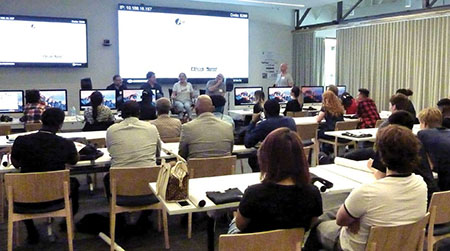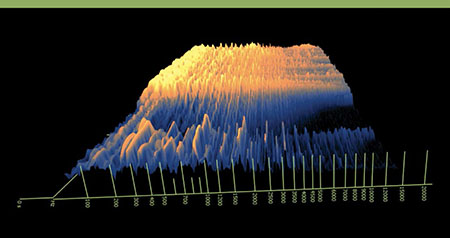Discerning Sound Defines Audio Pros
For the past 13 years, on a Saturday in mid-autumn, the AES Atlanta Section has held their workshop for students. The classes are taught by audio professionals and are held in working audio production rooms.

The workshop concluded with a discussion featuring all of the instructors, giving the students a final opportunity to ask questions.
This year’s event took place Sept. 23 and I was honored to be among the instructors, teaching the “Critical Listening” class alongside composer Tanya Ostrovsky. This class has historically been taught by multiple Grammy Award-winning engineer Jim Anderson, so we had some rather large shoes to fill.
Joining us as instructors this year were Michael Cardillo (Creative Waves) teaching “Pro Tools Fundamentals,” Miles Walker (Gwen Stefani, Coldplay) covering “Mixing Fundamentals” and Matt Still (Elton John) and Bob Gillespie (Turner Studios) digging into “Fundamental Microphone Techniques.”
The students rotated through the four classes throughout the day, ending up with a broad cross-section of audio instruction for six hours.
CRITICAL LISTENING
Critical listening is one of those intriguing topics you see mentioned every so often, but the ability to discern sounds is one of the defining characteristics of professional audio engineers. It is a skill that can and should be developed by everyone planning to work in the audio field.
The idea of listening critically as a discipline is something I find compelling because we sometimes get so wrapped up in the technical aspects of our jobs that we forget to slow down and really focus on what we’re hearing before making adjustments.
The professional video industry's #1 source for news, trends and product and tech information. Sign up below.
Needless to say, being a part of this class, which forced both the students and the instructor to simply listen and analyze, was utter joy.
My goals for the workshop were to get the students to really think about how to listen; get them listening critically with fewer assumptions; and to, hopefully, get them to start listening to sounds in the real world without constantly having transducers stuck into their ear canals.
I sometimes wonder if the sounds of nature, rural communities and even cities will one day become unrecognizable as we continue consuming audio content primarily through the devices we tote along in our pockets.
Tanya and I took turns teaching the Critical Listening class, handling two sessions each. My classes were loosely based on the book, “Critical Listening and Audio Production” by Jason Corey and were taught from my perspective as an engineer. Tanya’s sessions were taught from the viewpoint of a composer, with much heavier emphasis on music theory, with materials and listening tests from the “Golden Ears” course by former TV Technology audio columnist Dave Moulton.

Watching speech on the spectrogram was particularly interesting because it showed how wide the frequency and tonal range of the human voice truly is.
Because music creation and sound engineering are so intricately intertwined—and to aid in pinpointing and understanding the overall concept of frequencies—students were first given diagrams showing the frequency ranges of musical instruments and the human voice, along with the 10 octaves of hearing.
This led to a discussion of how instrument frequency ranges overlap, how timbre, pitch and resonance are among the characteristics that help us distinguish instruments and other sounds. From there we discussed the benefit of arranging music and soundscapes so that sounds with similar tonal characteristics don’t compete with each other in the mix because it tends to make the mixing process more difficult and the results often less pleasing.
In Corey’s book, he calls for active and analytical listening on the part of audio engineers and that is what we attempted to develop through the playback of a range of audio material, including music, speech and sound effects. Each example was selected for its distinctive instrumentation, to demonstrate a specific audio focus such as dynamic range, distortion, noise, reverberation and rooms, etc., and to generate discussion about what we were hearing. The goal was to recognize the unique characteristics of each example and to distinguish what certain sounds actually were.
UNDERSTANDING AND VISUALIZING FREQUENCIES
To help the students understand and visualize frequencies, all examples were presented through a spectrogram plug-in, which allowed everyone to see the frequency and intensity of sounds as they occurred. Watching speech on the spectrogram was particularly interesting because it became obvious how surprisingly wide the frequency and tonal range of the human voice truly is.
The one problem with the spectrogram plug-in was that I periodically had to remind students (and myself) that closing our eyes allows us to listen more intently. Once we worked our way through the audio elements, we started making systematic sweeps, then boosts and cuts, using a parametric equalizer to hear how sounds change when adjusted at given frequencies. This was in preparation for the final part of the class, which was a simple boost and cut equalization test using Train Your Ears EQ Edition software and a couple of new audio elements.
Some of the students attending the workshop were already doing audio production to varying degrees. Others were intrigued by the idea of working in audio as a career, and some didn’t know much about it, but were there to learn more.
By the end of the day, after attending all four classes, they had been inundated with a lot of practical, useful knowledge and had been given the opportunity to spend time with some incredible audio talent.
This workshop always concludes with a round table discussion featuring all of the instructors, giving the students one final opportunity to ask questions of the audio professionals they’ve spent their day with. Invariably, those questions include how to get hired into the business; how the instructors got into the business; and how they became successful.
Yet there are two other, far more important things, that have remained constant in all the years I’ve participated in the workshop; the curiosity that eventually rises to the surface once students understand that their questions are being answered openly and honestly and the palpable excitement they exhibit after they realize they actually could spend their lives making music, manipulating audio and staying close to their passion.
It always reminds me of how I felt in my early years in audio and also makes me wonder whether those of us working in this business realize how truly fortunate we are.
Jay Yeary is a broadcast engineer and consultant who specializes in audio. He is an AES Fellow and a member of SBE, SMPTE and TAB. He can be contacted through TV Technology magazine or at transientaudiolabs.com.
